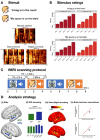Neural decoding of emotional prosody in voice-sensitive auditory cortex predicts social communication abilities in children
- PMID: 35296892
- PMCID: PMC9890475
- DOI: 10.1093/cercor/bhac095
Neural decoding of emotional prosody in voice-sensitive auditory cortex predicts social communication abilities in children
Abstract
During social interactions, speakers signal information about their emotional state through their voice, which is known as emotional prosody. Little is known regarding the precise brain systems underlying emotional prosody decoding in children and whether accurate neural decoding of these vocal cues is linked to social skills. Here, we address critical gaps in the developmental literature by investigating neural representations of prosody and their links to behavior in children. Multivariate pattern analysis revealed that representations in the bilateral middle and posterior superior temporal sulcus (STS) divisions of voice-sensitive auditory cortex decode emotional prosody information in children. Crucially, emotional prosody decoding in middle STS was correlated with standardized measures of social communication abilities; more accurate decoding of prosody stimuli in the STS was predictive of greater social communication abilities in children. Moreover, social communication abilities were specifically related to decoding sadness, highlighting the importance of tuning in to negative emotional vocal cues for strengthening social responsiveness and functioning. Findings bridge an important theoretical gap by showing that the ability of the voice-sensitive cortex to detect emotional cues in speech is predictive of a child's social skills, including the ability to relate and interact with others.
Keywords: development; emotion recognition; speech; superior temporal sulcus; voice.
© The Author(s) 2022. Published by Oxford University Press. All rights reserved. For permissions, please e-mail: journals.permissions@oup.com.
Figures




References
-
- Abrams DA, Kochalka J, Bhide S, Ryali S, Menon V. Intrinsic functional architecture of the human speech processing network. Cortex. 2020:129:41–56. - PubMed
Publication types
MeSH terms
Grants and funding
LinkOut - more resources
Full Text Sources
Miscellaneous

